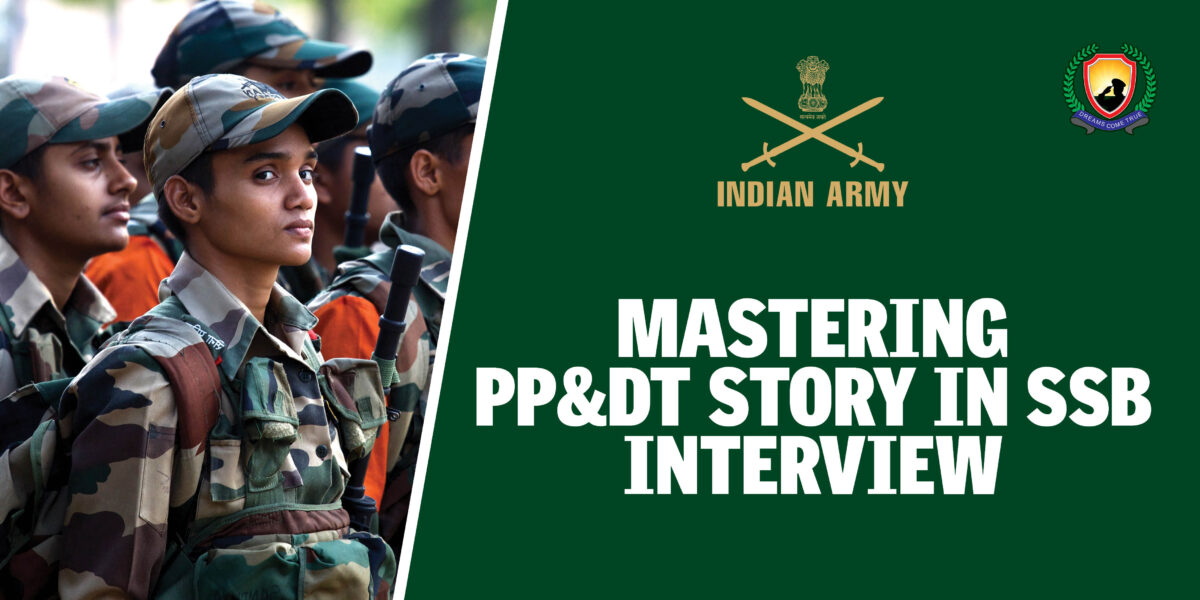Mastering the Art of Crafting an Effective PP&DT Story in SSB Interview
The Picture Perception and Discussion Test (PP&DT) is a pivotal component of the SSB (Services Selection Board) interview process, taking place on the very first day. Its outcome is instrumental in determining whether a candidate proceeds with the SSB process over the next 4-5 days. This blog aims to provide you with a strategic approach to excel in this test.
PP&DT unfolds in two stages:
Stage One: Candidates are presented with a hazy picture for a mere 30 seconds. In this brief span, you’re required to craft a compelling story around the image, identifying and marking characters, detailing their emotions, age, and gender based on your perceptions.
Stage Two: Following stage one, candidates are seated in groups of approximately 10-18. One by one, they narrate their stories and subsequently engage in a discussion aimed at harmonizing the various narratives into a unified story. One candidate, chosen by the group, then narrates the final story to the panel.
Tips for Mastering PP&DT Story Writing:
- Start with Calmness: It’s paramount to maintain composure and keep your mind calm. Listen attentively to the officer’s instructions before commencing the test. Panic can lead to a lack of confidence, causing candidates to change their stories repeatedly, leading to nervousness during the narration.
- The Power of Observation: In the brief 30 seconds, make the most of your observation skills. Scrutinize the picture with utmost care.
- Craft a Central Character: Build your story around one central character. Imagine yourself as this character and ponder how you would act as the hero. Establish relationships between this main character and others, showcasing how the hero unites them to form a solution-oriented group. Feel free to incorporate actions from your own experiences or achievements relevant to the image.
- Make an Impact: Your story should leave a lasting impression. Incorporate ideas from newspapers, books, or any inspirational sources, including innovative “start-ups” that have caught your attention.
- Maintain Positive Moods: Unless the picture explicitly suggests negativity, keep the moods of most characters positive.
- Age and Gender Flexibility: Don’t limit yourself to creating a hero of your age or gender. Be flexible in your character’s attributes. For instance, if the main character appears elderly, you can create a story centered around their retirement and their endeavor to open a library for underprivileged children, leveraging their collection of books from their childhood days. It’s not mandatory to stick to your age or gender.
- Purpose Over Needs: Concentrate on the purpose of your story, not just the needs of the characters. Avoid preconceived or impractical narratives. Your main character should possess excellent character and leadership qualities rather than being a superhero who can solve all problems.
- Character Marking: After formulating your story within 30 seconds, carefully mark the characters, their moods, and age groups in the square box provided. Ensure that the number of characters matches what’s visible in the picture, and avoid introducing characters from outside.
- Choose an Impactful Title: Select a title for your story that creates a strong first impression. It can be a single word or a group of words that aptly describe your story.
- A Well-Structured Narrative: Begin with a brief introduction in the past tense. Avoid using adjectives for characters. Develop the story’s action around your characters, encompassing the past, present, and future. Avoid direct descriptions of the picture.
- Effective Action: Narrate your story with concise and engaging actions, ideally within 5-6 sentences.
- A Smooth Conclusion: Conclude your story seamlessly, avoiding abrupt endings. The conclusion should reflect the successful achievement of the goal by the characters, led by the hero, and wrap up within 2-3 sentences.
- Confidence Is Key: Maintain confidence, even if you couldn’t complete your story. Review it mentally before entering the discussion room. You can make improvements, but refrain from altering the core narrative while narrating.
By following these strategic tips, you can enhance your performance in the PP&DT of the SSB interview and increase your chances of moving forward in the selection process. Remember, it’s not just about what you see in the picture but how you craft a compelling story around it.

